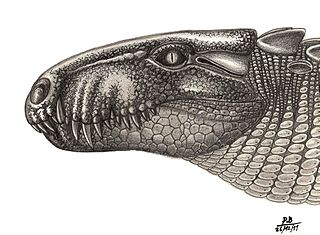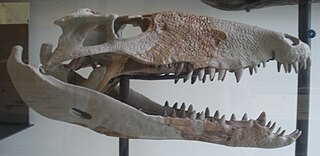Volkheimeria is an extinct genus of sauropod dinosaurs that lived in what is now Argentina during the Early Jurassic, 178–179 million years ago. Its type and only species is Volkheimeria chubutensis.

Pellegrinisaurus is a genus of titanosaurian sauropod dinosaur that lived in South America during the Late Cretaceous period. The holotype was found in the Allen Formation, Argentina.

Iberosuchus is a genus of extinct sebecosuchian mesoeucrocodylian found in Western Europe from the Eocene. Remains from Portugal was described in 1975 by Antunes as a sebecosuchian crocodilian. This genus has one species: I. macrodon. Iberosuchus was a carnivore, unlike the crocodilians today, they are not aquatic and are instead terrestrial.

Notosuchia is a suborder of primarily Gondwanan mesoeucrocodylian crocodylomorphs that lived during the Jurassic and Cretaceous. Some phylogenies recover Sebecosuchia as a clade within Notosuchia, others as a sister group ; if Sebecosuchia is included within Notosuchia its existence is pushed into the Middle Miocene, about 11 million years ago. Fossils have been found from South America, Africa, Asia, and Europe. Notosuchia was a clade of terrestrial crocodilians that evolved a range of feeding behaviours, including herbivory (Chimaerasuchus), omnivory (Simosuchus), and terrestrial hypercarnivory (Baurusuchus). It included many members with highly derived traits unusual for crocodylomorphs, including mammal-like teeth, flexible bands of shield-like body armor similar to those of armadillos (Armadillosuchus), and possibly fleshy cheeks and pig-like snouts (Notosuchus). The suborder was first named in 1971 by Zulma Gasparini and has since undergone many phylogenetic revisions.

Baurusuchidae is a Gondwanan family of mesoeucrocodylians that lived during the Late Cretaceous. It is a group of terrestrial hypercarnivorous crocodilians from South America and possibly Pakistan. Baurusuchidae has been, in accordance with the PhyloCode, officially defined as the least inclusive clade containing Cynodontosuchus rothi, Pissarrachampsa sera, and Baurusuchus pachecoi. Baurusuchids have been placed in the suborder Baurusuchia, and two subfamilies have been proposed: Baurusuchinae and Pissarrachampsinae.

Barinasuchus is an extinct genus of sebecid mesoeucrocodylian. Its fossils have been found in middle Eocene-age rocks of the Divisadero Largo Formation of Argentina, middle Miocene-age rocks of the Ipururo Formation of Peru, and middle Miocene-age rocks of the Parángula Formation of Venezuela.

Langstonia is an extinct genus of notosuchian crocodylomorph of the family Sebecidae. It lived in the middle Miocene, in the "Monkey Beds" of the Colombian Villavieja Formation. Langstonia was named in 2007 by Alfredo Paolillo and Omar Linares for fossils originally described by Langston in 1965 as Sebecus huilensis. Thus, the type species is L. huilensis.
Pabwehshi is an extinct genus of mesoeucrocodylian. It is based on GSP-UM 2000, a partial snout and corresponding lower jaw elements, with another snout assigned to it. These specimens were found in Maastrichtian-age Upper Cretaceous rocks of the Vitakri and Pab Formations in Balochistan, Pakistan, and represent the first diagnostic crocodyliform fossils from Cretaceous rocks of South Asia. Pabwehshi had serrated interlocking teeth in its snout that formed a "zig-zag" cutting edge. Pabwehshi was named in 2001 by Jeffrey A. Wilson and colleagues. The type species is P. pakistanensis, in reference to the nation where it was found. It was traditionally classified as a baurusuchid closely related to Cynodontosuchus and Baurusuchus. Larsson and Sues (2007) found close affinity between Pabwehshi and the Peirosauridae within Sebecia. Montefeltro et al.Pabwehshi has a sagittal torus on its maxillary palatal shelves – a character that is absent in baurusuchids – but they did not include Pabwehshi in their phylogenetic analysis.

Bergisuchus is an extinct genus of small sebecosuchian mesoeucrocodylian known primarily from the Eocene Messel Pit in Germany. Few fossils of Bergisuchus have been discovered, only a single incomplete snout, a few partial lower jaws and some teeth. Despite being fragmentary, the jaw bones are enough to indicate that Bergisuchus had a short, deep, narrow snout and serrated teeth, quite unlike the broad flat snouts of modern crocodylians.

Bretesuchus is an extinct genus of sebecosuchian mesoeucrocodylian within the family Sebecidae known from northwestern Argentina. It was a large apex predator.

The Itaboraian age is a period within the Early Eocene geologic time epoch of the Paleogene, used more specifically with South American land mammal ages (SALMA). It follows the Riochican and precedes the Casamayoran age.
The Riochican age is a period of geologic time within the Paleocene and Eocene epochs of the Paleogene, used more specifically within the South American land mammal ages (SALMA). It follows the Peligran and precedes the Itaboraian age.
Ilchunaia is an extinct genus of sebecid mesoeucrocodylian. Fossils have been found from the Divisadero Largo Formation of Argentina dating back to the Late Eocene, and a locality in Mendoza, Argentina dating back to the Oligocene. Little material is known from the genus, with only the anterior portion of the skull being present to study.

Sebecus is an extinct genus of sebecid crocodylomorph from Eocene of South America. Like other sebecosuchians, it was entirely terrestrial and carnivorous. The genus is currently represented by two species, the type S. icaeorhinus and S. ayrampu. Several other species have been referred to Sebecus, but were later reclassified as their own genera.

Sebecidae is an extinct family of prehistoric terrestrial sebecosuchian crocodylomorphs. The oldest known member of the group is Ogresuchus furatus known from the Upper Cretaceous (Maastrichtian) Tremp Formation (Spain). Sebecids were diverse, abundant and broadly distributed in South America during the Cenozoic, until the Middle Miocene; although it has been suggested that at least some forms could have survived until the Miocene-Pliocene boundary in Brazil.
Sebecosuchia is an extinct group of mesoeucrocodylian crocodyliforms that includes the families Sebecidae and Baurusuchidae. The group was long thought to have first appeared in the Late Cretaceous with the baurusuchids and become extinct in the Miocene with the last sebecids, but Razanandrongobe pushes the origin of Sebecosuchia to the Middle Jurassic. Fossils have been found primarily from South America but have also been found in Europe, North Africa, Madagascar, and the Indian subcontinent.

Sahitisuchus is an extinct genus of sebecid mesoeucrocodylian known from Rio de Janeiro State of southeastern Brazil. It contains a single species, Sahitisuchus fluminensis. It is a terrestrial sebecid, however also adopted to a semi-aquatic lifestyle to some degree, most probably coexisting with the semi-aquatic alligatorid Eocaiman itaboraiensis.
The Mealla Formation is a geological formation of the Santa Bárbara Subgroup, part of the Salta Group in the Salta Basin in northwestern Argentina whose strata date back to the Middle to Late Paleocene of the Paleogene.
The Río Loro Formation is a geological formation of the Sierras Pampeanas in Tucumán Province Argentina whose strata date back to the Late Paleocene of the Paleogene, or Riochican in the SALMA classification.
Powellophis is a genus of extinct Madtsoiid snake from the Mealla Formation of Argentina, dating back to the Paleocene. It is a monospecific genus, with the only species being P. andina. The genus name means "Jaime Powell's Snake". The name is constructed from the words Powell and ophis, the first in honor of the scientist who recovered the specimen, the late Dr. Jaime Powell, and the second meaning snake in Greek. The species name andina is named for the Andes region of Northwestern Argentina, where the fossil remains of the animal were discovered.












